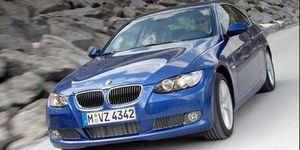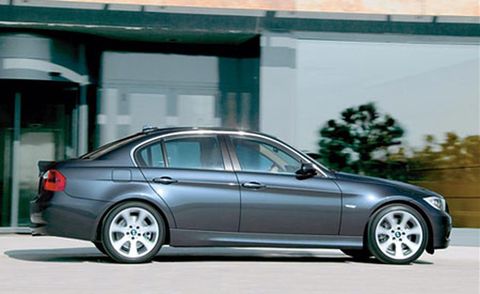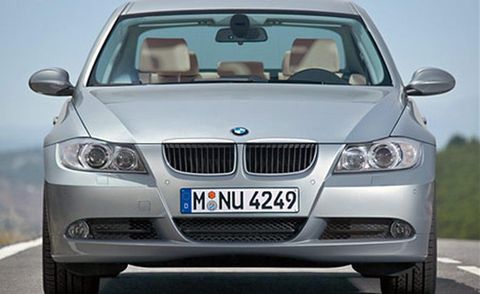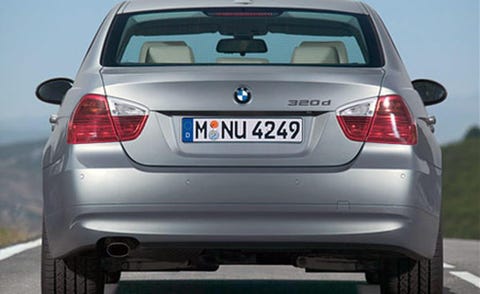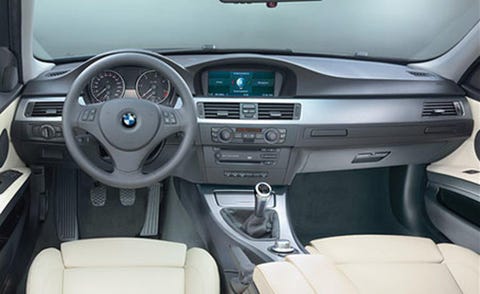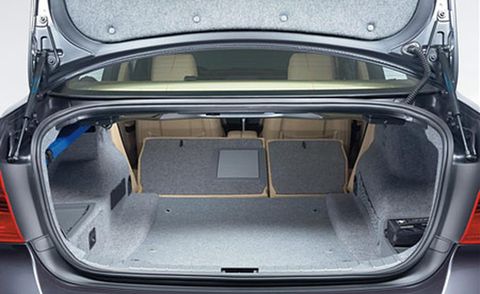From the April 2005 issue of Car and Driver.
To be writing about a new BMW without first questioning the way it looks is a welcome change from recent history. The design revolution of BMW’s Chris Bangle has polarized opinion on everything from the blocky 7-series to the banana-curved 1-series. But for the company’s most important model, there is a comfortable familiarity, a gentle evolution.
The 3-series, 30 years old and now entering its fifth generation, is the car that made BMW what it is today The bestselling premium model worldwide, it accounts for some 60 percent of the one million new cars BMW sells each year. The message to the anarchic Bangle was: Don’t mess with the DNA of the goose that laid the golden egg.
Most buyers will recognize the new car as a 3-series, even with the curvier elements of the 5-series around the front and an interior theme that also mimics its bigger brother. They’ll be pleased by the improvement in this model’s already superlative mechanicals and driving behavior. Which is good news because, appearance aside, a year ago we were not convinced the current 5-series was a major advance over its predecessor.
The new 330i sedan, the only version coming to the United States that was available at the preview, has the latest lightweight 3.0-liter straight-six engine with variable valve timing and lift (see Technical Highlights). With 255 horsepower, it’s 13 percent more powerful and likely more fuel efficient. (This Valvetronic engine will soon be fitted to the 530i.) So this top-of-the-line 3-series is quicker and more economical than before. All 3s carry six-speed transmission, manual or automatic, that work beautifully.
The platform is new but the layout is familiar—struts at the front and a multilink rear suspension. But for the first time on the 3-series, the struts now employ the double-pivot lower arm long used on larger BMWs. And the multilink rear uses five elements rather than four to provide better wheel control while retaining sufficient compliance for a soft ride. Most of these new components are hewed from aluminum to minimize weight.
As with most new models, the 3-series has grown a bit. It’s 2.2 inches longer on a wheelbase extended by 1.4 inches. Width is up by 3.0 inches, although half of that increase is caused by protruding door handles. Accordingly, the new sedan, known internally as the E90, is about 150 pounds heavier than its E46 predecessor, yet it retains BMW’s typical nearly 50/50 front-to-rear weight distribution. The handling balance we have always admired in the 3-series remains one of its most enjoyable features.
Run-flat tires are used with every tire-and-wheel option on the new 3-series. We haven’t liked the ride quality of run-flats specified for other BMWs, but the 3-series engineers say they were better able to tune the suspension to match these tires because there is no conventional alternative. The 330i models we drove had the standard suspension shod with Pirelli Euforirun-flats and did seem more comfortable over broken road surfaces than 5-series cars of our experience.
You do have a choice about the active steering system, introduced in the latest 5-series and available as an option for the new 3. A variable steering ratio—more direct (10.8:1) at low speed for agility and less so (up to 18.0:1) at high speed for straight-line stability—feels more intuitive in this car than it does in the 5 and has the advantage of providing a small amount of automatic opposite lock when the electronics detect that the car is oversteering. That said, we are still not entirely convinced it is better to drive than the regular, nicely linear power steering we tried in a Euro-spec 320d diesel.
A workout on an artificially slippery handling track did prove the value of DSC+, BMW’s latest electronic stability-control system that is standard on the 330i. As in the previous model, the traction-control element has two modes. Press the button marked (confusingly) DTC, and it allows a fair degree of sliding before working its magic with the throttle and brakes at individual wheels. That threshold is nicely judged and entertaining for the enthusiast; a five-second push on the button turns off the traction and stability controls completely, but you probably wouldn’t want to do that except on a dry racetrack.
The braking aspect of DSC+ has a number of new features: brake standby, which detects an emergency and builds up brake pressure in anticipation; rain brake support, which automatically wipes water off the discs; hill-start assist, which maintains brake pressure to stop the car from rolling backward; fade compensation, which increases line pressure when hot brakes are fading; and soft stop, which modulates the brakes to come to rest without a jolt.
All of this adds up to a car that runs smoothly, feels wonderfully safe and secure on the road, and drives with a rare precision. As our exclusive test numbers show, it is also very quick for a less-than-$40,000 compact sports sedan: zero to 60 mph in 5.6 seconds and the standing quarter-mile in 14.3 seconds at 98 mph. Although these figures were recorded on a surface with poor grip, they match the performance of the current-generation 330i with the Performance package and its much larger rear tires. Our Euro-spec test car ran a bit beyond its 155-mph governor. U.S.-bound cars will be limited to 130 with the standard suspension and 150 mph with the Sport package.
Cabin furnishings may disappoint those brought up with BMW’s driver-focused dashboards, but we think the new layout is neat and efficient. The instrument cluster in front of the driver is supplemented by an LCD screen high in the center of the dashboard if the optional iDrive is specified. That location makes the display accessible to driver and passenger both and reduces the distance the driver must look away from the road to read it. The iDrive is the simpler version already used in the 5-series. Around here, opinions are split on its functionality and convenience.
The longer wheelbase has provided another inch of rear-seat legroom, but this is still not a spacious sedan, and three adults in the back wouldn’t want to travel far. Having had no cup holders in previous generations, the 3s now have them all over the place, including a container for drinks in the center console cooled by the A/C system. Another small innovation: a drawer sliding out from the ceiling of the trunk that can accommodate a laptop or a tote bag.
Of course, the 330i sedan is only the start. When it arrives here next month, there will also be a 325i with a 215-hp version of the 3.0-liter six using a simpler induction system. As in previous generations, a wagon, a coupe, and a convertible will follow, in that order. And finally, probably not before 2007, there will be an M3, powered by a 414-hp V-8 derived from the M5’s V-10.
Pricing hasn’t been announced, but we expect the 330 to cost a bit more than the current car’s $36,395, although that will include increased standard equipment such as curtain airbags and xenon headlamps that swivel as you drive around corners. The four-cylinder models so popular in Europe won’t see the U.S., but a four-cylinder engine will turn up in the smaller 1-series. When the 1 arrives in 2006, the little BMW will share its platform with the 3-series, but its sheetmetal will follow the “alternative” style of the larger BMWs. Fortunately, the 330’s does not.
This content is created and maintained by a third party, and imported onto this page to help users provide their email addresses. You may be able to find more information about this and similar content at piano.io

